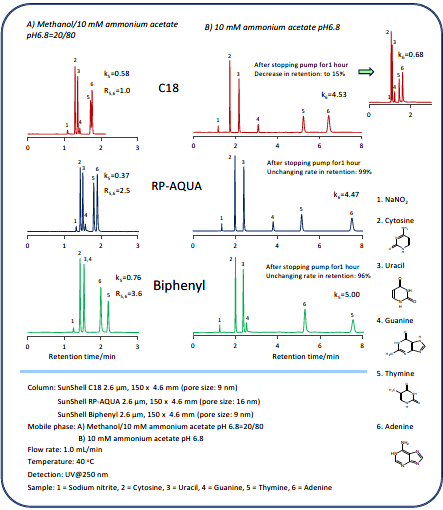Application and Comparison information between different stationary phases using nucleic acid bases
Comparison of stationary phases using nucleic acid bases

Separation of nucleic acid bases was performed on C18, RP-AQUA, and Biphenyl columns. Two mobile phases were used: methanol/10mm ammonium acetate pH 6.8=20/80 and 10mm ammonium acetate aqueous solution. Nucleic acid bases can be separated even in the mobile phase containing 20% methanol, but the retention time is shorter. In a comparison of columns used this 20% methanol mobile phase, the retention factor (k5) of thymine at the 5th peak was highest in Biphenyl, and the resolution of the 5th and 6th peaks of thymine and adenine (R5,6) was also highest in Biphenyl. When an aqueous mobile phase containing no organic solvent was used, the retention factor of thymine eluting at last on Biphenyl was 5.00 and the adenine eluting at last on C18 and RP-AQUA were 4.53 and 4.47, respectively. Biphenyl showed the largest retention factor for the compound eluted at last. The selectivity of Biphenyl is very different from that of RP-AQUA and C18, such as the order of sample elution. It has also been confirmed that the retention time stability when using an aqueous mobile phase is as high for Biphenyl as for RP-AQUA. The retention factor on C18 decreased to 15% after stopping the flow for 1 hour, confirming low reproducibility in retention.
